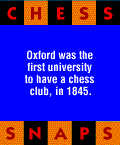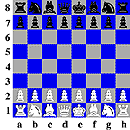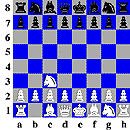
![]()
Chess boards are generally labeled by rank and file. A horizontal row of the chessboard is a "rank", numbered 1 (where the White pieces start the game) through 8 (where the Black pieces start). e.g., "White's rook on the 7th rank was paralyzing the Black king."

The vertical columns of the board are "files" and are lettered a (where the Queen's Rooks are lodged) through h (where the King's Rooks begin the game). e.g., "...the pawn exchange opened up the c file, which Black's rook was quickly able to control backed by the Queen."
The game board shows the current position. The names of the players are displayed above and below the board, with the name of the White player at the bottom and the Black player at the top. Times displayed are time remaining, which is normally 2 hours for the first 40 moves, an hour for 20 more, and a sudden death round. Compare it to football, with 3 quarters, but each team is required to make a certain number of plays or they lose!

Whose move is it? The last player's move will be shown. White always moves first. The first player to get White is determined at the opening ceremony by flip of coin, with the players switching sides after each game. Moves are described in algebraic notation, which is usually just the piece followed by the final location. The piece is described as K-King Q-Queen B-Bishop N-Knight R-Rook P-Pawn. Example Bh4 The B is Bishop which moves to square h4. If more than one of the indicated pieces can legally move to the given location, the starting square will be listed. Example Rh-b1 the Rook on the H file (not the other rook) moves to b1.

Knights move in an L-shape, 1 square horizontal then 2 vertical, or 1 vertical then 2 horizontal. Pieces move along the board, no jumping except the Knight which jumps from square to square like a horse. Pieces are blocked by other pieces (regardless of owner), and may capture an opponent's piece if they move to an occupied square. All pieces capture the same as they move, except for pawns. The pawn moves one square forward at a time, it only moves forward and can never move backward. The pawn can move 2 squares forward on its first move. The pawn does not attack forward, it attacks diagonally. If a piece is directly in front of a pawn, the pawn is blocked. But if it sits diagonally in front, the pawn can capture it.
The king is "in check" when it could be captured by an opposing piece on the opponent's next move. A player in check must make an appropriate move to take the king out of check. Checkmate occurs when the king is in check and every available move would still result in the king being in check. Note that the player in check has the option of blocking an attacking piece or capturing it, as well as moving his king.
A player loses if he is checkmated, or if he runs out of time.
![]()
[ The Game | The Program | Commentary | Grandstand | Deep Blue ]
[ IBM home page | (C) | (TM) | IBM Small Planet Pavilion | Internet 1996 World Expo ]